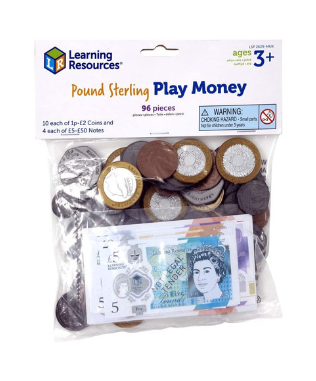The official currency of the United Kingdom is the pound sterling, known as the pound (£, GBP). Each pound is divided into 100 pence (100p = £1). Because of this, when working with money, it is important for children to be able to add amounts to 100.
Resources
- Play Money
- Bath crayons
- Base Ten Set
Method
53p + __p = 100p
Ioan explained what the first question was.
He used the base ten set to work out the answer, then used that information to fill in the sum.
Sometimes calculations and word problems are difficult for a child to visualise in their head, but bar models help them to see the maths more clearly. The bar model is a visual strategy to help solve number problems, using different sized rectangles to represent numbers. The rectangles or ‘bars’ are proportional so that a larger number in a problem is represented by a larger bar.
Ioan was telling me that the bar model is a bit like a part-whole model, but using rectangles. A part-whole model is explained here.
Ioan switched his 7 around and then set out his base ten in a sum.
86p + __p = 100p
This time, Ioan had a go filling in the bar model before working it out with the base ten. He started off with the tens, then worked out his ones (units).
Once he had worked out his answer, he filled in the sums.
__p + 32p = 100p
In the final question, the missing number was first, but Ioan recognised that it didn’t matter which order you added the numbers in, he was just looking for a number that gave a total of 100. He said that normally you would add 70 to 30, but in this case there were ones. He was keen to point out that you don’t get a 70p coin.
Ioan also wanted me to know that you don’t get a 60p coin either.
He worked out the answer and recorded it. I’d intentionally left more information out of the bar model this time.












DfES Outcomes for EYFS and National Curriculum (2013)
Numeracy Year 2 programme of study
Measurement
- recognise and use symbols for pounds (£) and pence (p); combine amounts to make a particular value
- find different combinations of coins that equal the same amounts of money
- solve simple problems in a practical context involving addition and subtraction of money of the same unit
















